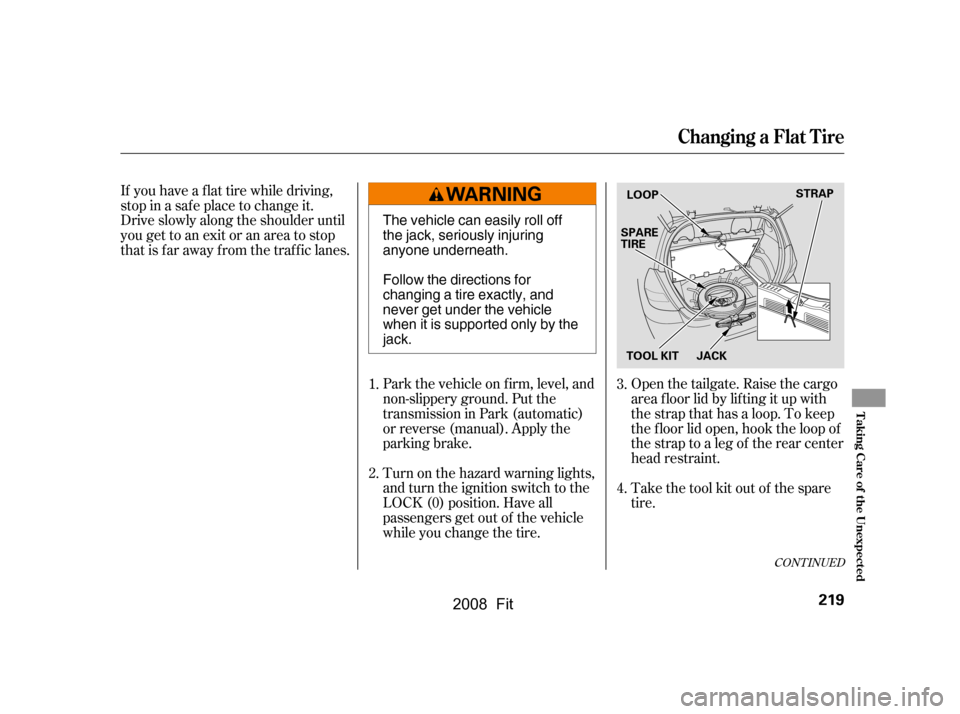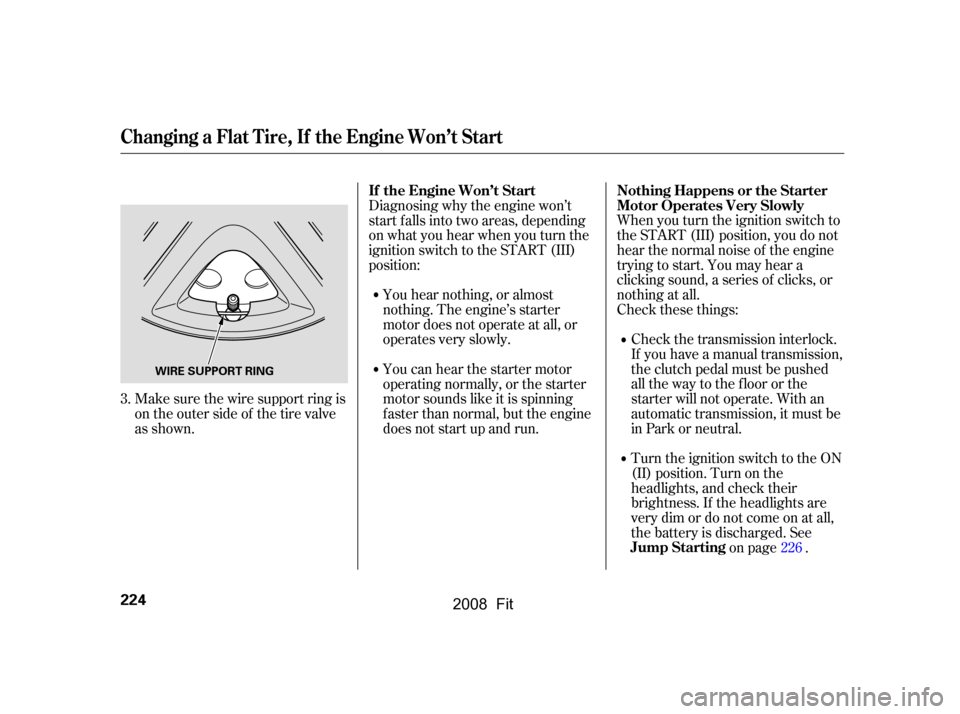Page 222 of 280

If you have a f lat tire while driving,
stop in a saf e place to change it.
Drive slowly along the shoulder until
you get to an exit or an area to stop
that is far away from the traffic lanes.Turn on the hazard warning lights,
and turn the ignition switch to the
LOCK (0) position. Have all
passengers get out of the vehicle
while you change the tire.
Park the vehicle on f irm, level, and
non-slippery ground. Put the
transmission in Park (automatic)
or reverse (manual). Apply the
parking brake.Open the tailgate. Raise the cargo
area f loor lid by lif ting it up with
the strap that has a loop. To keep
the f loor lid open, hook the loop of
the strap to a leg of the rear center
head restraint.
Take the tool kit out of the spare
tire.
4.
3.
2.
1.
CONT INUED
Changing a Flat Tire
T aking Care of t he Unexpect ed
219
JACK STRAP
TOOL KIT
SPARE
TIRE
LOOP
The vehicle can easily roll off
the jack, seriously injuring
anyone underneath.
Follow the directions for
changing a tire exactly, and
never get under the vehicle
when it is supported only by the
jack.
�\f���—�\f���—�����y���\f�����������y���
�(�������
�\f�y�\f�������y
2008 Fit
Page 223 of 280
Take the jack out of the cargo
area.
Turn the jack’s end bracket
counterclockwise to loosen it, then
remove the jack by lif ting it straight
up. Unscrew the wing bolt and take
the spare tire out of its well. Loosen each wheel nut 1/2 turn
with the wheel nut wrench.
On all models except Sport,
remove the wheel cover by
caref ully prying under its edge
with the flat tip of the extension.
5.
6. 7. 8.
Changing a Flat Tire
220
WHEEL NUT WRENCH
WHEEL NUT
WHEEL COVER EXTENSION
�\f���—�\f���—�����y���\f�����������y���
�(�������
�\f�y�\f�������y
2008 Fit
Page 224 of 280
�Ú
CONT INUED
Use the extension and the wheel
nut wrench as shown to raise the
vehicle until the f lat tire is of f the
ground.
Remove the wheel nuts, then
removetheflattire.Handlethe
wheel nuts caref ully; they may be
hot from driving. Place the flat tire
on the ground with the outside
surface facing up.Bef ore mounting the spare tire,
wipeanydirtoff themounting
surface of the wheel and hub with
a clean cloth. Wipe the hub
carefully;itmaybehotfrom
driving.
Place the jack under the jacking
point nearest the tire you need to
change. It is pointed to by a
mark molded into the underside of
the body (Sport model). Turn the
end bracket clockwise until the top
of the jack contacts the jacking
point. Make sure the jacking point
tab is resting in the jack notch.
9.
11. 12.
10.
Changing a Flat Tire
T aking Care of t he Unexpect ed
221
WHEEL NUT WRENCH BRAKE HUB
JACKING POINT EXTENSION
�\f���—�\f���—�����y���\f�������\f���y���
�(�������
�\f�y�\f�������y
2008 Fit
Page 225 of 280
Put on the spare tire. Put the
wheel nuts back on f inger-tight,
then tighten them in a crisscross
pattern with the wheel nut wrench
until the wheel is f irmly against
the hub. Do not try to tighten the
wheel nuts f ully.
Lower the vehicle to the ground,
and remove the jack.Tighten the wheel nuts securely in
the same crisscross pattern. Have
the wheel nut torque checked at
the nearest automotive service
f acility.
Tighten the wheel nuts to:Place the flat tire face down in the
sparetirewell.
Securetheflattirebyscrewing
the wing bolt back into its hole.
Remove the center cap before
storing the f lat tire.
13.
14.
15.
16.17.
18.
On Sport model:
Changing a Flat Tire
222
For
normal
tire
For
spare
tire
80 lbf·ft (108 N·m , 11 kgf·m)
�\f���—�\f���—�����y���\f�������
�\f�y���
�(�������
�\f�y�\f�������y
2008 Fit
Page 226 of 280
CONT INUED
Store the jack. Place the tool kit in
the center of the flat tire.
Store the wheel cover or center
cap in the cargo area. Make sure it
will not get scratched or damaged.
Remove the strap loop from the
leg of the head restraint, then
lower the f loor lid, and close the
tailgate.Align the valve mark on the wheel
cover to the tire valve on the
wheel, then install the wheel cover.
Make sure the wire support ring is
hooked into the clips around the
edge of the wheel cover.
1.
2.
19.
20.
21.
All models except Sport
Changing a Flat Tire
Inst alling a wheel cover
T aking Care of t he Unexpect ed
223
CLIPS
CLIPS
Loose items can fly around the
interior in a crash and could
seriously injure the occupants.
Store the wheel, jack, and tools
securely before driving.
�\f���—�\f���—�����y���\f�������
���y���
�(�������
�\f�y�\f�������y
2008 Fit
Page 227 of 280

When you turn the ignition switch to
the START (III) position, you do not
hear the normal noise of the engine
trying to start. You may hear a
clicking sound, a series of clicks, or
nothing at all.
Check these things:Check the transmission interlock.
If you have a manual transmission,
the clutch pedal must be pushed
all the way to the f loor or the
starter will not operate. With an
automatic transmission, it must be
in Park or neutral.
Turn the ignition switch to the ON
(II) position. Turn on the
headlights, and check their
brightness. If the headlights are
very dim or do not come on at all,
the battery is discharged. See on page .
You can hear the starter motor
operating normally, or the starter
motor sounds like it is spinning
f aster than normal, but the engine
does not start up and run.
You hear nothing, or almost
nothing. The engine’s starter
motor does not operate at all, or
operates very slowly.
Diagnosing why the engine won’t
start f alls into two areas, depending
on what you hear when you turn the
ignition switch to the START (III)
position:
Make sure the wire support ring is
ontheoutersideof thetirevalve
as shown.
3.
226
Changing a Flat Tire, If the Engine Won’t Start
Nothing Happens or the Starter
Motor Operates Very Slowly
Jump Starting
If the Engine Won’t Start
224
WIRE SUPPORT RING
�\f���—�\f���—�����y���\f�����������y���
�(�������
�\f�y�\f�������y
2008 Fit
Page 241 of 280

�µ�µ
If your vehicle needs to be towed,
call a prof essional towing service or
organization. Never tow your vehicle
with just a rope or chain. It is very
dangerous.
The operator
loads your vehicle on the back of a
truck.
Therearetwowaystotowyour
vehicle: If , due to damage, your vehicle must
be towed with the f ront wheels on
the ground, do this:
Release the parking brake.
Shif t the transmission to neutral.
The tow
truck uses two pivoting arms that go
under the tires (f ront) and lif t them
of f the ground. The other two tires
remain on the ground. Start the engine.
Release the parking brake.
Leave the ignition switch in the
ACCESSORY (I) position so the
steering wheel does not lock.
With the f ront wheels on the ground,
do not tow the vehicle more than 50
miles (80 km), and keep the speed
below 35 mph (55 km/h).
Shif t to D position and hold f or 5
seconds, then to N. Let the engine
runfor3minutes,thenturnitoff.
Turn of f the engine.
Leave the ignition switch in the
ACCESSORY (I) position so the
steering wheel does not lock.
Manual transmission:
Automatic transmission:
Flat -bed Equipment
Wheel-lif t Equipment
T his is the best way to
transport your vehicle.
T his is an
acceptable way to tow your
vehicle.
Emergency Towing
238
Improper towing preparation will
damage the transmission. Follow the
above procedure exactly. If you cannot
shif t the transmission or start the
engine (automatic transmission), your
vehicle must be transported with the
f ront wheels of f the ground.
�\f���—�\f���—�����y���\f�������
���y���
�(�������
�\f�y�\f�������y
2008 Fit
Page 252 of 280

�µ
�µ
�µ
�µ Accordingly, when the low tire
pressure telltale illuminates, you
should stop and check your tires as
soon as possible, and inflate them to
the proper pressure. Driving on a signif icantly under-
inf lated tire causes the tire to
overheat and can lead to tire failure.
Under-inf lation also reduces f uel
efficiency and tire tread life, and may
af f ect the vehicle’s handling and
stopping ability.
Please note that the TPMS is not a
substitute for proper tire
maintenance, and it is the driver’s
responsibility to maintain correct tire
pressure, even if under-inf lation has
not reached the level to trigger
illumination of the TPMS low tire
pressure telltale.
As an added safety feature, your
vehicle has been equipped with a tire
pressure monitoring system (TPMS)
that illuminates a low tire pressure
telltale
when one or more of your tires is
signif icantly under-inf lated.
Max Press The maximum air
pressurethetirecanhold.
Max Load The maximum load the
tire can carry at maximum air
pressure.
Each tire, including the spare (if
provided), should be checked
monthly when cold and inf lated to
the inf lation pressure recommended
by the vehicle manuf acturer on the
vehicle placard or tire inf lation
pressure label.
(If your vehicle has tires of a
dif f erent size than the size indicated
on the vehicle placard or tire
inf lation pressure label, you should
determine the proper tire inf lation
pressure f or those tires.)
CONT INUED
Tire Labeling, Tire Pressure Monitoring System (TPMS) Required Federal Explanation
Maximum T ire Pressure
Maximum T ire L oad
Tire Pressure Monitoring System
(T PMS) Required Federal
Explanation
Technical Inf ormation
249
�\f���—�\f���—�����y���\f�������\f�\f�y���
�(�������
�\f�y�\f�������y
2008 Fit